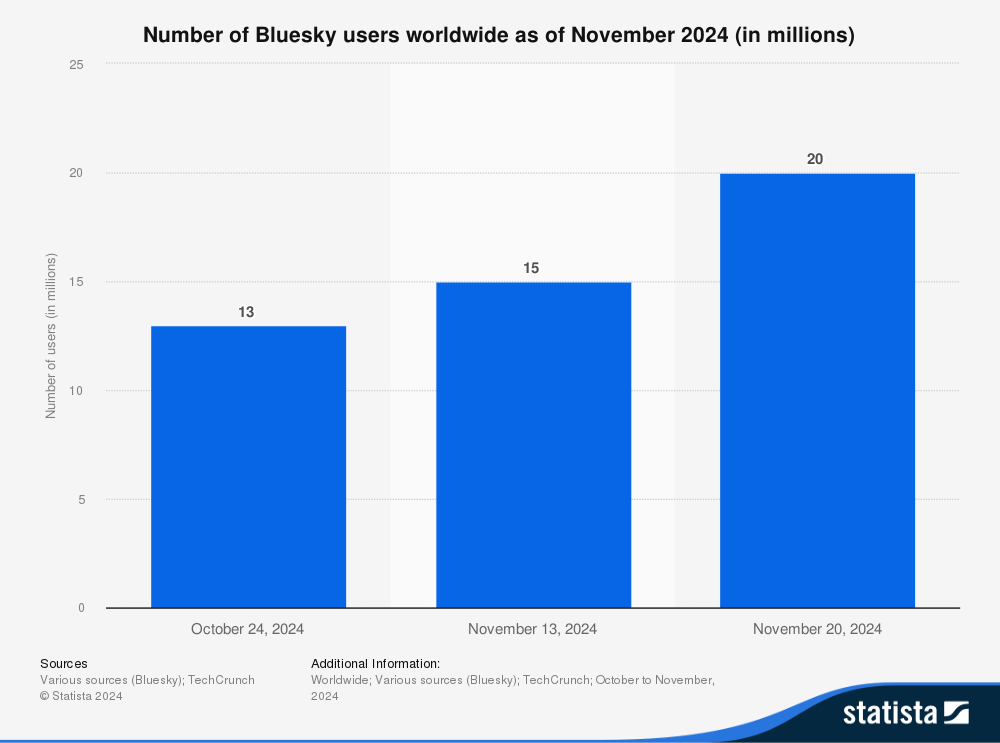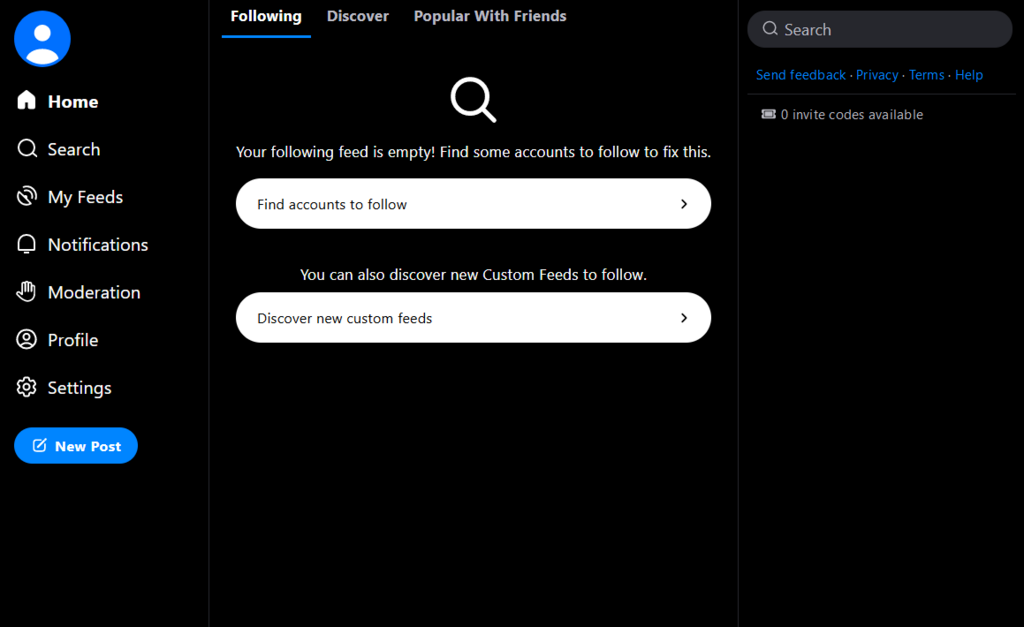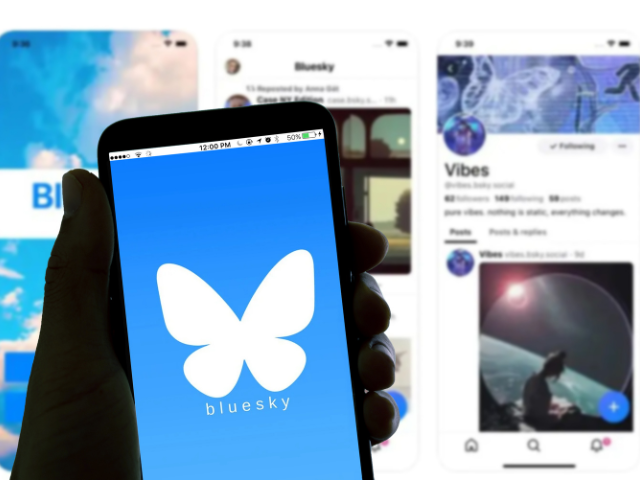The Gist
- What it is. Bluesky Social is a decentralized alternative to Twitter. First launched in a limited private beta, the app is now public and has quickly grown its user base.
- Founded by Jack, led by Grader. Bluesky was founded by Jack Dorsey, co-founder and former CEO of Twitter. Today, CEO Jay Grader is leading Bluesky’s growth and success.
- Looking for an X alternative? People have quickly adopted Bluesky as a Twitter substitute that offers similar features while avoiding the growing discontent of moderation on X.
Editor’s Note: This article has been updated to include new data and information.
Time changes how people appreciate a media network. Social media is no exception.
Bluesky, founded by Jack Dorsey, co-founder and former CEO of Twitter, has become the heir apparent to the Twitter 2.0 title. Its appeal comes as a platform that provides the original microblogging experiences people adored and the initial intentions that Dorsey had for Twitter.
With a great shift in social media platforms, Bluesky is gaining ground fueled by the exodus from X because of user frustration with moderation and current X owner Elon Musk’s foray into supporting president-elect Donald Trump’s campaign and administration.
Tracing Bluesky’s Roots: A Twitter-Inspired Journey
Bluesky emerged as a Twitter project under Jack Dorsey, who was CEO of Twitter at the time. He intended Bluesky to create an “open and decentralized standard for social media,” with Twitter as a template for Bluesky’s operational structure, all starting with a “small independent team of up to five open source architects, engineers, and designers.”
Twitter is funding a small independent team of up to five open source architects, engineers, and designers to develop an open and decentralized standard for social media. The goal is for Twitter to ultimately be a client of this standard. 🧵
— jack (@jack) December 11, 2019
Dorsey wanted Bluesky to take advantage of the more decentralized Web3 technology that cryptocurrency enthusiasts had been adopting. It was meant to overcome the walled garden usage of content on a social network, on which accounts could not leave and travel to another social network.
To manage the decentralized structure, Bluesky developed an open-source framework called AT Protocol, or ATProto for short. ATProto operates a federated social network that offers special features including algorithmic choice, interoperation and account portability that permits users to move accounts from one provider to another without losing data.
Company officials noted that ATProto provided “a way for servers to communicate with each other — like email. Instead of one site running the network, you can have many sites. It means you get a choice of provider, and individuals and businesses can self-host if they want.”
“The many existing decentralized social networks that currently make up the ecosystem can be categorized into federated and p2p architectures,” said a Bluesky blog post. “Our approach will be to combine the best of both worlds by integrating the portability of self-certifying protocols with the user-friendliness of delegated hosting, so users don’t have to run their own infrastructure and developers can build performant apps.”
“Moderation is an important part of any online social forum,” the blog post continued, “which is why we will proactively build tooling for reputation and moderation systems that are transparent, opt-in, and multi-layered, as well as create frameworks for others to build such tooling.”
At the time of that posting on Feb. 7, 2022, board members included Dorsey, Jeremie Miller, the inventor of Jabber/XMPP and Jay Graber, CEO of the Bluesky company. The board has since added Mike Masnick, founder and editor of Techdirt and author of the “Protocols, Not Platforms” paper that inspired the Bluesky initiative.
Related Article: 10 Social Media Trends You Can't Ignore
What Does Bluesky Look Like Now (Compared to 2023)?
Bluesky launched with the slogan, “Find your scene, post what's new, and stay connected.” That enthusiasm, however, was met with initial skepticism within the decentralized network community. Some felt Bluesky would be too similar to Mastodon, another decentralized social network.
From the start Bluesky had limited availability as a beta; an invite code was required to create an account. In January 2024, it opened the access for public downloading of the app.
Since the open access, Bluesky has risen from a blooming microblog to a potential rival to major players like Instagram and Pinterest. As of November 2024, Bluesky has 11.5 million monthly active users and 20.7 million total registered users.

Updated features since the public beta have further broadened the platform’s appeal. Users can send direct messages to each other, and improved search capabilities have made it easier for people to find accounts of favorite media sources and friends on the platform.
The most appealing feature is post-editing — a feature that Twitter users long demanded but never got a response to until Musk’s acquisition of X. Modifying posts after initial publication on a feed allows users to correct mistakes and avoid gross missteps from going viral. Today, X users can edit posts as long as users have a paid subscription. On Bluesky, post-editing is included for free tier users.
Another intriguing factor is the current CEO of Bluesky, Jay Graber. A software engineer with a variety of experiences, Graber has become a high-profile executive due to growing user rates on Bluesky. (CNN did a brief interview of her here).
Despite the current frenzy that tech introduces, Graber has leveraged the new spotlight on her sensible leadership. The personality and developer insight strikes a terrific contrast in tech leadership compared to executive leadership at the other platforms — Zuckerburg for Facebook, Musk for X and so forth. That style may have helped draw social media users who want to communicate yet remain out of the crossfire for misinformation, bots and intrusive commentary from platform executives.
Related Article: Building Strong Customer Relationships Through Social Media
What Features Does Bluesky Offer?
Once signed up, users gain a simplified user interface that allows them to create a post. The post textbox can create a maximum of 300 characters — up from 256 during its beta form and a higher limit than X. Users can upload images and videos alongside the text by clicking the plus button.
The interface acts and looks similar to that on X, which is part of the appeal to new users who left X. The familiarity will allow users to pick up where they left off pretty easily. For example, I access Bluesky from my desktop, the same way I do for X and Threads. That ability is convenient for those who have to frequently microblog from a laptop rather than a smartphone while on the go.

Bluesky’s Rise Signals a Strategic Shift for Marketers
The misfortunes of Twitter have driven public adoption of Bluesky, along with other microblogging platforms like Spill, Mastodon and Threads. When live audio platforms like Chattr and Clubhouse are also considered, marketers should expect to see a competitive social media market in 2025. The age of social media platforms as they exist today is approaching twenty years. Facebook was launched in 2006, while Twitter arrived in 2008.
The shifting dynamics and timing allow marketers to reconsider the role of social media platforms in a marketing strategy. People will not stop communicating with their favorite brands. At this moment in social media history, many brands have switched from X to Bluesky to further maintain their connection. Communication plans that support customer experience can be adjusted to where audiences are emerging.
